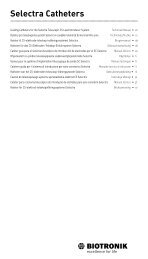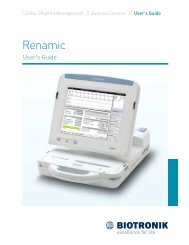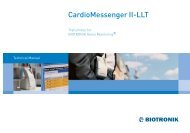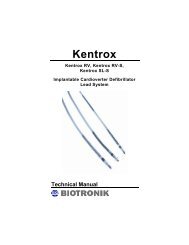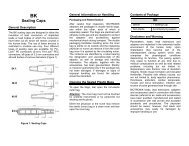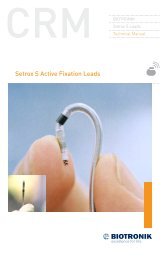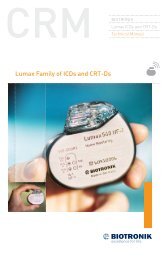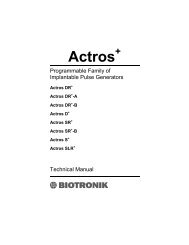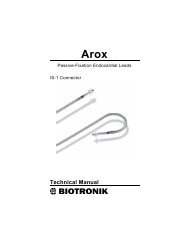Estella Pulse Generators - BIOTRONIK USA - News
Estella Pulse Generators - BIOTRONIK USA - News
Estella Pulse Generators - BIOTRONIK USA - News
You also want an ePaper? Increase the reach of your titles
YUMPU automatically turns print PDFs into web optimized ePapers that Google loves.
116 <strong>Estella</strong> <strong>Pulse</strong> <strong>Generators</strong> Technical Manual12.7.1 Rate/Sensor TrendThe sensor rate forecast may be used to optimize the rate adaptationparameters without repeated exercise tests. The pulse generatorrecords the sensor rate over a period of 12 minutes. During this time,the pulse generator develops a sensor rate curve. This curve is usedto forecast optimal parameters such as the sensor gain, threshold, andmaximum sensor rate.12.7.2 Adjusting the Sensor GainThe sensor gain controls the change in stimulation rate for a certainchange in workload detected by the sensor. An exercise test isrecommended in order to achieve a rate response proportional to workload by optimizing the sensor gain. If the pacing rate tends to be too highfor the specific amount of work load or if the selected maximum sensorrate is achieved at too low of an exercise level, the sensor gain shouldbe reduced by selecting a lower gain setting. If, on the other hand, rateadaptation is insufficient for a specific amount of workload, selection ofa higher gain setting may be indicated. The memory functions can beused to record the pacing rate during exercise.The sensor rate forecast function facilitates optimization of the rateadaptiveparameters.12.7.3 Adjusting the Sensor ThresholdThe sensor threshold controls the (motion) signal level that has to beexceeded to cause a rate increase. This parameter is meant to assurea stable pacing rate at rest and to prevent rate increases at signallevels not consistent with physical exertion. The sensor gain should beoptimized prior to adjusting the sensor threshold. Otherwise, changingof the gain setting will cause changes in the effective threshold.If rate increase is caused by low level activities, when no rate‐adaptionis desired, the sensor threshold setting should be increased by selectingthe next higher setting (e.g., low to mean). If, on the other hand, thepulse generator tends to respond only at higher levels of work, areduction of the sensor threshold may be indicated (e.g., high reducedto mean). It may be useful to record a sensor test trend for evaluation ofsensor response. The sensor rate forecast may also be used to tailor thesensor threshold to the patient.



